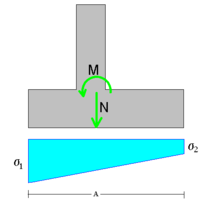Cantilever method
The cantilever beam method or stress trapezoidal method is a calculation method of statics (especially structural statics ). It is a simple and old (classic) two-dimensional method for calculating the stability of a foundation , a retaining wall , a dam or something comparable. If the cantilever method is used, experts also say "it is calculated according to the beam theory".
Action
All of the above Use cases are traced back to a simple bar that is only clamped on one side, namely at the bottom. This beam is also called a cantilever . The stresses that the cantilevered girder or beam (or the entire structure) exerts on its restraint or contact area during the load to which it is subjected are calculated . The course of the stresses is assumed to be linear. It takes the shape of a trapezoid (hence the name tension trapezoidal method ).
Mathematical description
The underlying formula for calculating the stresses is:
- = Tensions on both sides,
- - normal force
- - footprint
- - bending moment
- - section modulus
requirements
In contrast to bar statics , the method requires that the beam has an extension in its width that can also vary in height. It is also assumed that it may bend , but not deform, i.e. This means that its cross-sections remain flat ( Bernoulli hypothesis ).
proof
In the case of a foundation, for example, it must be proven that compressive stresses are present at every point on the contact area of the structure above. Otherwise the structure would lift off on one side and tip over.
In refined versions of the beam theory , the principal normal and principal shear stresses and their course can also be determined. In an additional step, the sliding safety , the tipping safety and the safety against static buoyancy are demonstrated .
literature
- Karl-Eugen Kurrer : History of Structural Analysis. In Search of Balance , Ernst and Son, Berlin 2016, p. 102f, ISBN 978-3-433-03134-6 .






